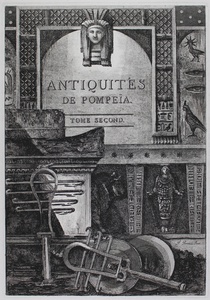| Method | Etching |
| Artist | Francesco Piranesi |
| Published | F. Piranesi Fecit. [1805] |
| Dimensions | Image 560 x 385 mm, Plate 570 x 395 mm, Sheet 705 x 495 mm |
| Notes |
The highly decorative frontispiece of Volume 2 of Francesco Piranesi's Antiquites de Pompeia, part of his Antiquités de la Grande Grèce. The frontis is a pastiche of Egyptianizing elements, clearly drawing inspiration from the Temple of Isis in Pompeii, numerous plates of which, showing general views, architectural details, and archaeological objects, are included in the second volume. The title is surmounted by a portrait bust wearing an Egyptian headdress, and columns of reliefs on either side feature hieroglyphs and basketry. Below, a pair of other relief engravings show an Apis bull in profile, and a cult statue of the goddess Isis that draws heavily upon the Artemis of Ephesus with her multiple rows of breasts. In the foreground, the altar of the temple is shown, with a pair of cymbals and sistra resting against it. The Antiquités de la Grande Grèce was published in the early years of the nineteenth century, but was most likely inspired by two visits to Paestum, Pompeii, and Herculaneum undertaken by Francesco Piranesi with his father in 1770 and 1778. Giovanni Battista Piranesi had prepared a number of preparatory sketches of the temples of Pompeii and Paestum that were eventually engraved and published by Francesco, but the remaining plates for the three volumes of the Antiquités seem to have been of Francesco's invention. Although lacking some of the romanticism of his father's earlier plates of Rome, the illustrations from the Antiquités nevertheless provide a valuable record of progress in the archaeological exploration of the sites of the Neapolitan region, and are testament to Francesco's deep engagement with Roman antiquity. Francesco Piranesi (c.1756-1810) was an Italian engraver, etcher and architect who mainly worked in Paris. He was the eldest son of the famous etcher Giovanni Battista Piranesi (1720-1778), under whom he studied printmaking and architecture. By 1775, Piranesi was both producing his own work and assisting with his father's. Upon the death of Giovanni Piranesi three years later, he inherited his father's publishing house and was responsible for producing most of the later editions of his prints. In 1798, Piranesi moved to Paris, where he was later employed by Napolean, to engrave classical sculpture and vase collections within France and French-occupied Italy. He also collaborated with the French artist Louis-Jean Desprez (c.1743-1804) on a series of Italian views which were sold at Piranesi's shop in Rome. Although the 1783 advertisement for the series promised forty-eight views, the series was not completed before Desprez left Rome to become Director of Scenic Decorations at the Stockholm Opera. Piranesi died in Paris from syphilis in 1810. Condition: Strong dark impression with full margins. Marginal creasing and ink-staining. |
| Framing | unmounted |
| Price | £700.00 |
| Stock ID | 50727 |

